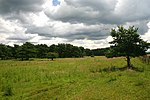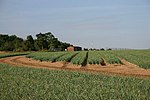Lakenheath is a village and civil parish in the West Suffolk district of Suffolk in eastern England. It has a population of 4,691 according to the 2011 Census, and is situated in the Forest Heath district of Suffolk, close to the county boundaries of both Norfolk and Cambridgeshire, and at the meeting point of The Fens and the Breckland natural environments.
Lakenheath is host to the largest USAF base in the United Kingdom, RAF Lakenheath.
Lakenheath Fen Nature Reserve, created in 1996, restored wetlands from agricultural fields that were growing carrots. In May 2007, it was reported that cranes were nesting in the site for the first time since the fen lands were drained in the 16th century.The village has a single Victorian primary school, constructed in 1878, which was extended in 1969, again in 2004 and most recently in 2010/2011. There is a small shopping street on which a variety of multi-cultural shops, restaurants, and services are available. Horse-riding services are also present. The village has a modern library with various amenities. Along this main road there is a small hotel, skate park, and a children's play park.
Lakenheath has two pubs though historically it had at least sixteen more. The Plough Inn (also known as the Wok n Rock) is a spacious flint faced 19th-century bar, Far Eastern restaurant and takeaway. It reopened at the end of 2013 after being closed for two years. The other pub is the Brewer's Tap. The Royal British Legion was a members only club, but closed in April 2012.Lakenheath is remarkable for its medieval church, built about 900 years ago in wood, eventually being rebuilt in the local flint construction style. The church on the exterior has an embattled parapet that has an array of gargoyles and other carved faces at the string course at the base. The interior includes medieval paintings and carvings on the pews. The faces of the church's wooden angels bear the scars of the English Civil War, as none of the angels retained their original facial detail, due to religiously motivated vandalism by puritan soldiers. In early 2009, the church received a large grant from the Heritage Lottery Fund and local organisations to restore its rare medieval wall paintings. The wall paintings, depicting local saint St Edmund, angels, and birds amongst other subjects, are believed to date from the 13th century.As well as the Anglican parish church, Lakenheath has churches representing the Methodist, Strict Baptist and Pentecostal (AOG) denominations. All three of the non-Anglican church buildings are also primarily constructed of local flint, albeit with later modifications in brick.
The village was struck by an F0/T1 tornado on 23 November 1981, as part of the record-breaking nationwide tornado outbreak on that day.The recently built pavilion now houses the local cricket club and hosts various events.
Lakenheath also boasts a football club playing at ‘The PIt’ stadium in the village. The club, in 2021 won promotion to the Thurlow Nunn League Premier Division, the highest they have ever been and, won the Suffolk Senior Cup for the second time in their history.











